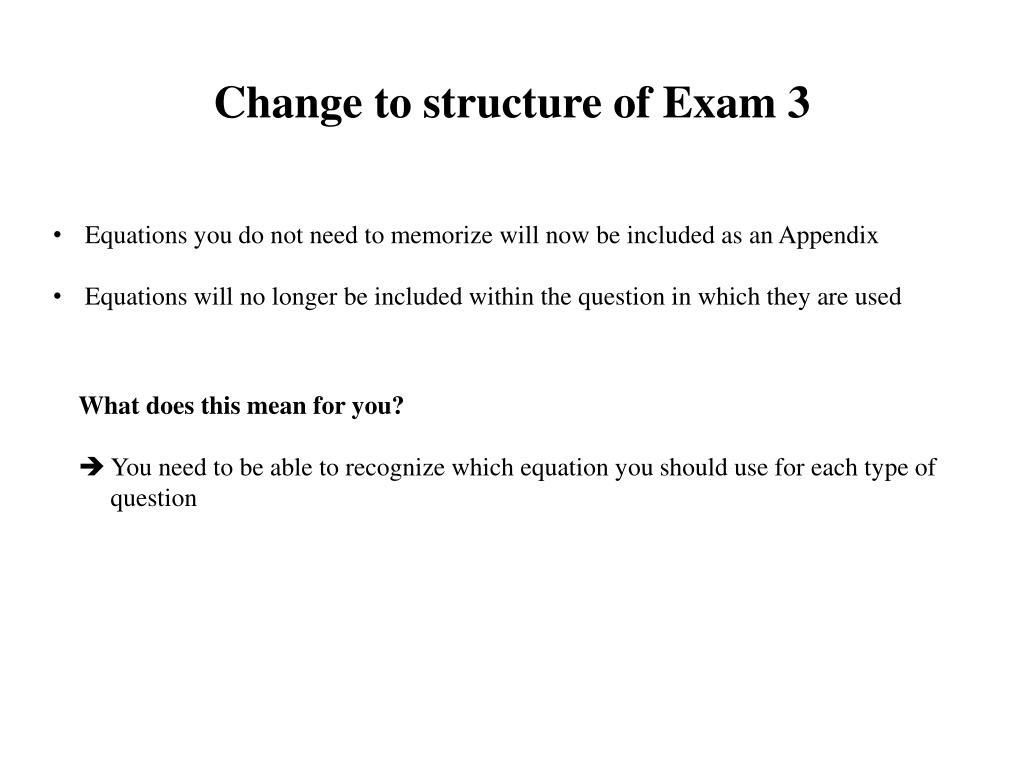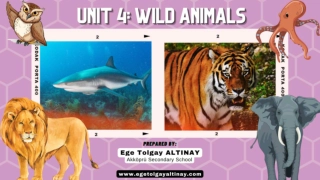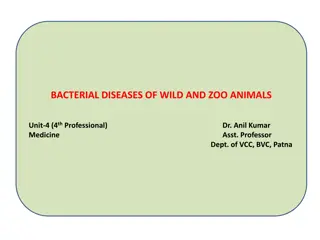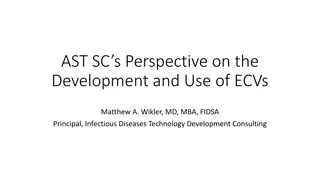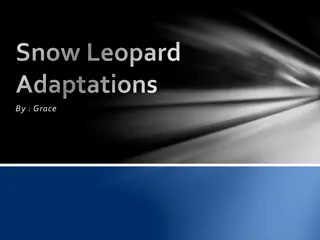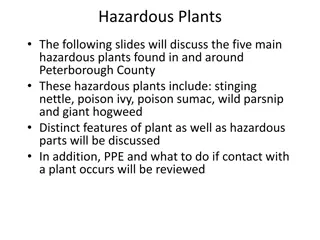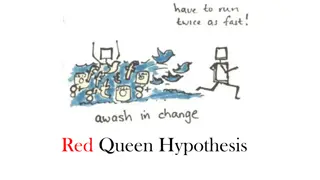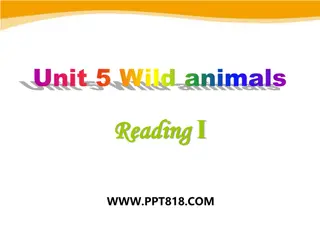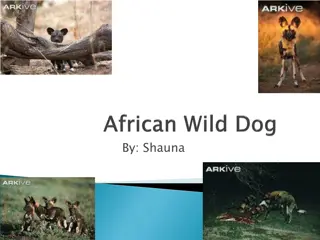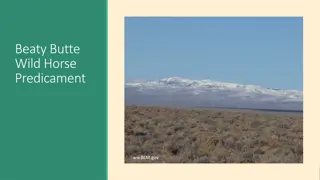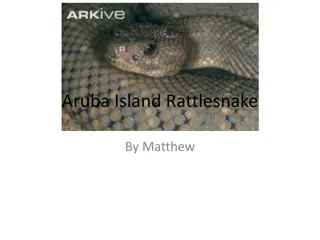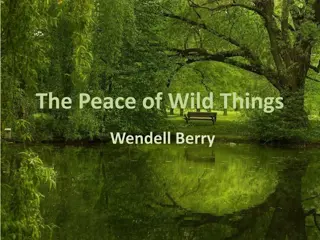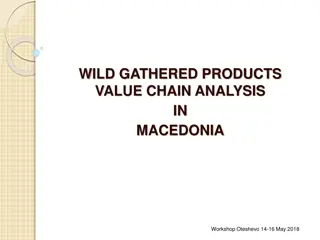Understanding Coevolution: An Example from Wild Parsnip and Webworms
Coevolution, a reciprocal evolutionary change in interacting species, can be observed in the relationship between wild parsnip plants containing toxic compounds and webworms that can metabolize these toxins. This example demonstrates the prerequisites for coevolution, including genetic variation and reciprocal natural selection necessary for species interactions to evolve over time.
Download Presentation

Please find below an Image/Link to download the presentation.
The content on the website is provided AS IS for your information and personal use only. It may not be sold, licensed, or shared on other websites without obtaining consent from the author. Download presentation by click this link. If you encounter any issues during the download, it is possible that the publisher has removed the file from their server.
E N D
Presentation Transcript
Mutualism Change to structure of Exam 3 Equations you do not need to memorize will now be included as an Appendix Equations will no longer be included within the question in which they are used What does this mean for you? You need to be able to recognize which equation you should use for each type of question
What is Coevolution? Species 1 Species 2 Coevolution: Reciprocal evolutionary change in interacting species (Janzen, 1980) "Thus I can understand how a flower and a bee might slowly become, either simultaneously or one after the other, modified and adapted to each other in the most perfect manner, by the continued preservation of all the individuals which presented slight deviations of structure mutually favourable to each other." Charles Darwin, The Origin of Species
Prerequisites for Coevolution For coevolution to occur: There must be genetic variation for traits mediating the interaction There must be reciprocal natural selection R = 2 ( ) h S 1 1 1 2 R = (1 2 2 ) h S 2 2 i is the genotypic or phenotypic distribution of species i
An example from wild parsnip and webworms Introduced to the United States Contains phototoxic furanocoumarins (secondary plant defensive compounds) Phyto%2520wild%2520parsnip Pastinaca sativa (Wild parsnip)
An example from wild parsnip and webworms Depressaria pastinacella (Parsnip webworm) Feed on wild parsnip Eat seeds (how?)
An example from wild parsnip and webworms How is it that these insects are able to eat such toxic plants? PERCENT REMAINING The larvae can metabolize the toxic furanocoumarins using cytochrome P450 Phyto%2520wild%2520parsnip
Are the pre-requisites for coevolution met in this system? Remember, for coevolution to occur: There must be genetic variation for traits mediating the interaction There must be reciprocal natural selection
Is there genetic variation for plant toxicity? h2 > 0? Berenbaum et. al. (1986): Heritabilities for seed furanocoumarin production Measured concentrations of toxic furanocoumarins in seeds of half-sib families Trait h2 Bergaptin .190 Used this data to estimate heritabilities for furanocoumarin production Xanthotoxin .650 Sphondin 1.43 Found substantial genetic variation for furanocoumarin production
Is there genetic variation for insect resistance? h2> 0? Berenbaum and Zangerl (1992): Dissected guts out of larvae from 6 different families Heritabilities for P450 metabolism furanocoumarins Trait h2 Measured the rate at which these guts metabolized furanocoumarins Bergaptin .326 Xanthotoxin .450 Sphondin .008 Used this data to estimate heritabilities for metabolism of furanocoumarins Found substantial genetic variation for furanocoumarin metabolism
Is there selection for increased plant toxicity? S1(2)? Berenbaum et. al. (1986): Selection differentials for seed furanocoumarin concentration Measured concentrations of toxic furanocoumarins in plants grown in the field Trait S Bergaptin .0107 Measured the seed set of each plant at the end of the study Xanthotoxin -- Sphondin .0106 Used this data to estimate Selection differentials for furanocoumarin concentration Found statistically significant selection acting on the concentration of Bergaptin
Is there selection for increased insect resistance? S2(1)? Zangerl and Berenbaum (1993): Measured concentrations of toxic furanocoumarins in plants Measured the growth rate of larvae on each plant Measured the rate of larval metabolism for furanocoumarins Found that larvae with a high metabolic rate grew faster on highly toxic plants
This interaction meets all the criteria for coevolution Genetic variation exists for plant production of furanocoumarins Genetic variation exists for furanocoumarin metabolism in the moth Natural selection favors plants with greater concentrations of furanocoumarins Natural selection favors moths with an increased rate of furanocoumarin metabolism
Have the webworm and parsnip coevolved? Spatial data (Berenbaum and Zangerl, 1998): Concentrations of plant furanocoumarins were measured in four different populations Moth furanocoumarin metabolic rates were measured within these same populations There is a striking amount of phenotypic matching between species Is this evidence for coevolution?
Have the webworm and parsnip coevolved? Temporal data (Berenbaum and Zangerl, 1998): Concentrations of plant furanocoumarins were measured in herbarium samples Concentrations in herbarium samples and present day populations were compared It appears that the concentration of the furanocoumarin Sphondin has increased over time Is this evidence for coevolution? Present day samples Herbarium samples
Summary for wild parsnip and parsnip webworm Genetic variation exists for plant production of furanocoumarins Genetic variation exists for furanocoumarin metabolism in the moth Natural selection favors plants with greater concentrations of furanocoumarins Natural selection favors moths with an increased rate of furanocoumarin metabolism Phenotypic matching occurs between moth and plant in most populations Plant furanocoumarin concentrations may be increasing over time What about other types of interactions?
Practice Problem You have observed that a butterfly species, Papilio falsificada, is regularly associated with the plant, Prunus fauxviflorum. Based on your observations, it is clear that the butterfly can, in principle, pollinate the plant and that the plant generally offers a nectar reward to the butterfly. Consequently, you have hypothesized that this interaction is a mutualism. To test this hypothesis, you collected information on plant fitness (seed set) for 22 individual plants visited by the butterfly vs. 22 individual plants that were not. In addition, you measured the fitness (# of surviving offspring) of 48 butterfly individuals that visited the plant vs. 48 butterfly individuals that did not. Your data are shown below as summary statistics: Visited by butterfly? mean of plant seed set set Yes 56.2 6.6 No 22.7 3.5 Does your data support your hypothesis that this interaction is a mutualism? Justify your response statistically. Sample Sample variance of plant seed Visited plant? Sample mean of butterfly fitness 16.6 6.5 Sample variance of butterfly fitness 4.6 3.2 Yes No
Types of coevolutionary interaction Interaction Effect on Species 1 Effect on Species 2 Competition - - Antagonism - + Mutualism + + The interactions differ in the form of Reciprocal Selection
Coevolution in competitive interactions Reciprocal Selection: The fitness of Species 1 individuals is decreased by interacting with Species 2 1 0.8 Frequency 0.6 The fitness of Species 2 individuals is decreased by interacting with Species 1 0.4 0.2 Reciprocal selection favors traits in each species that reduce the efficacy or frequency of the interaction 0 0 0.5 1 1.5 2 2.5 3 Phenotype (e.g., beak size)
If there is genetic variation in both species 1 Coevolutionary dynamics: 0.8 0.6 Divergence in traits mediating the interaction (i.e., character displacement) 0.4 0.2 0 Frequency Time 0 0.5 1 1.5 2 2.5 3 1 0.8 0.6 0.4 0.2 0 0 0.5 1 1.5 2 2.5 3 Phenotype (e.g., beak size)
An example from fish gasterosteus_18x24 Gasterosteus aculeatus (Three spined stickleback) Limnetic (shallow water) Studied interactions in lakes in BC Benthic (deep water)
An example from fish Individuals with body sizes more similar to the alternate species/morph have lower fitness Generates reciprocal selection for divergence in body size Limnetic (shallow water) Benthic (deep water) Measure body size of the two forms where they occur allopatrically vs sympatrically The ratio of the trait means (body size and shape) for the two species are exaggerated in sympatry (i.e., character displacement)
Coevolution in antagonistic interactions Reciprocal Selection: The fitness of victim individuals is increased by not interacting 1 0.8 Frequency 0.6 The fitness of exploiter individuals is increased by interacting 0.4 0.2 Victim Exploiter Reciprocal selection favors victim traits that decrease the efficacy or frequency of interaction, but exploiter traits that increase the efficacy or frequency of the interaction 0 0 0.5 1 1.5 2 2.5 3 Phenotype (e.g., running speed)
Antagonistic interactions can be further divided Coevolutionary escalation Reciprocal selection favors increased (or decreased) phenotypes in both victim and exploiter (this is the case for the parsnip and parsnip webworm) Coevolutionary matching Reciprocal selection favors exploiters that match the phenotype of the victim, but victims that mismatch the phenotype of the exploiter
Coevolutionary escalation Probability of attack 1 0.75 0.5 0.25 0.25 0 0 Large Large Parasite trait zP Host trait zH Small Small For example: Concentration of plant defensive compounds Concentration of insect detoxification enzymes
If there is genetic variation in both species 1 0.8 0.6 Coevolutionary dynamics: 0.4 0.2 Endless escalation of phenotypes 0 0 0.5 1 1.5 2 2.5 3 1 0.8 Frequency The winner is the species with greatest response to selection, R 0.6 Time 0.4 0.2 0 0 0.5 1 1.5 2 2.5 3 1 0.8 0.6 0.4 0.2 0 0 0.5 1 1.5 2 2.5 3 Phenotype
An example from toxic newts and garter snakes Newts produce tetrodotoxin (TTX) Newts that produce more TTX are less likely to be eaten by snakes Snakes that are more resistant to TTX are better able to eat newts Taricha granulosa Thamnophus sirtalis (Garter snake)
Is there evidence for coevolutionary escalation? Geographic distribution of TTX resistance Some Garter snake populations have dramatically increased TTX resistance Suggests the existence of coevolutionary hot spots where escalation has occured Brodie et. al. 2002
Coevolutionary matching Probability of attack 1 0.75 0.5 0.25 0.25 0 0 Large Large Parasite trait zP Host trait zH Small Small For example: Cuckoo egg coloration
If there is genetic variation in both species 1 Exploiter Coevolutionary dynamics: Victim 0.8 Trait means (zi)- Phenotypes cycle endlessly 0.6 0.4 Exploiter adapts to common victim phenotypes 0.2 0 1000 2000 3000 4000 5000 Should produce an advantage for rare victim phenotypes 1 0.8 Trait means (zi)- 0.6 0.4 0.2 0 1000 2000 3000 4000 5000 Generation
An example from snails and castrating trematodes Hypothesized that (Dybdahl and Lively 1998): Trematode phenotypes can only infect snails with specific matching genotype/phenotypes If true, rare snail genotypes/phenotypes should be less frequently infected than common snail phenotypes/genotypes Potamopyrgus antipodarum A castrating trematode
Coevolution in mutualistic interactions Reciprocal Selection: The fitness of Species 1 individuals is increased by interacting with Species 2 individuals 1 0.8 Frequency 0.6 The fitness of Species 2 individuals is increased by interacting with Species 1 individuals 0.4 0.2 0 0 0.5 1 1.5 2 2.5 3 Phenotype (e.g., Timing) Reciprocal selection favors traits in both species that increase the efficacy or frequency of the interaction
If there is genetic variation in both species Coevolutionary dynamics: 1 0.8 Convergence of traits mediating the interaction 0.6 0.4 0.2 Frequency 0 Time 0 0.5 1 1.5 2 2.5 3 1 0.8 0.6 0.4 0.2 0 0 0.5 1 1.5 2 2.5 3 Phenotype (e.g., Timing)
An example from plant-insect interactions Data are consistent with coevolutionary convergence (Steiner and Whitehead 1990)
Conclusions for coevolution Coevolution is likely any time interacting species: - Exert reciprocal selection on one another - Possess genetic variation for traits mediating the interaction The dynamics of coevolution differ across types of interactions: - Competitive interactions cause coevolutionary divergence - Mutualistic interactions cause coevolutionary convergence - Antagonistic interactions cause either coevolutionary escalation or coevolutionary cycles
